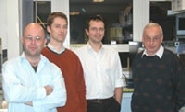Four major awards were granted in 2004 to researchers in Bristol University’s Biochemistry Department: the best young biochemist in the country; the best young biophysicist in the country; the best young researcher working on diabetes in Europe; and a newly elected Fellow of the Royal Society.
Professor George Banting, the Biochemistry Department’s new head, said: “This really has been a great year for the Department. Congratulations go to all these winners, each of whom is a worthy recipient of their prestigious award. These are truly major awards which reflect the continuing strength of our research.”
The best young biochemist was Dr Ian Collinson who was the recipient of the 2005 Colworth Medal of the Biochemical Society. The Biochemical Society has very few awards, so the recipients are chosen very carefully. The Colworth Medal is awarded annually for outstanding research by a British biochemist under the age of 35.
Dr Collinson has contributed a major advance to our understanding of a basic cellular process. The cells that make up our body have to secrete many proteins from the inside to the outside of the cell and the cell will die if this process does not occur properly. Dr Collinson helped to work out how this transfer occurs.
Dr. Mark Szczelkun was named as the British Biophysical Society’s (BBS) Young Investigator of 2004. The BBS Medal was introduced in 2002 to encourage excellence in biophysics and is awarded biannually to scientists under the age of 35 who are resident in the UK or Ireland. Dr Mark Szczelkun was awarded the BBS Medal for his ground-breaking work on the movement of motor proteins on DNA.
Much of the control of genetic information in our cells is provided by proteins that can move along DNA, much like trains along a track. These proteins must convert chemical energy into mechanical force and as such can be considered as molecular-sized motors. Dr. Szczelkun has developed novel biophysical techniques that can directly measure these processes in real time. This is a major step forward for this area of research.
Professor Guy Rutter was awarded the Minkowski Prize by the European Association for the Study of Diabetes for his contribution to the ‘advancement of knowledge concerning diabetes'.
Professor Rutter's research strategy uses a range of state-of-the-art techniques to identify the genes responsible for both type 1 and type 2 diabetes. Together these diseases affect more than 150 million people world-wide, a figure set to double by 2020. He also looks for ways to help manage and possibly cure diabetes. The award of the Minkowski Prize recognises Professor Rutter's remarkable success in diabetes research.
Finally, Professor Steve Halford was elected a Fellow of the Royal Society. This is probably the most significant honour that can be bestowed upon a scientist working in this country and reflects the extremely high regard in which Professor Halford is held by his fellow scientists.
The Royal Society is the world’s oldest scientific academy and has been at the forefront of enquiry and discovery since its foundation in 1660. Past and present members include Charles Darwin, Albert Einstein, Isaac Newton, Dorothy Hodgkin, Christopher Wren and Stephen Hawking.
Professor Halford was recognised for his work which has shown how ‘restriction enzymes’ work. About 30 years ago some enzymes were discovered that could chop very long chromosomes into bite-sized pieces short enough for further analysis and manipulation. These enzymes, now called restriction enzymes, have revolutionised the life sciences.
Professor Halford’s research has focused on how these enzymes find their targets along the string of DNA, how they decipher the code, and how they cut the string. His work has major implications for how scientists will make use of results from the human genome project.